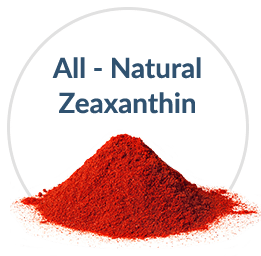Do You Know Where Zeaxanthin Comes From?
Posted by amess on May 24th 2019
In recent years, there has been an increase in curiosity about where food/ingredients come from and the processes they go through. Americans are embracing organic products and trends like farm-to-table and clean eating, and they are thinking more about what they put in their bodies. This can mean taking a hard look at the natural and synthetic ingredients in their nutraceuticals, and optometrists may be surprised to learn that one important eye-healthy ingredient has a surprising amount of variation: zeaxanthin.
Zeaxanthin
One of the macular carotenoids found in the fovea, zeaxanthin can be found in the blood serum, tissues, and brain. While this antioxidant is critical to long-term eye health, zeaxanthin cannot be produced by the body, meaning it must be supplemented through the diet. Natural sources of zeaxanthin include peppers, broccoli, corn, and kale. While these foods are readily consumed, people rarely get enough in their daily diets to sustain healthy, protective levels of zeaxanthin. That’s where supplementation comes in.
Zeaxanthin Nutraceuticals
Nutraceuticals are defined as “foods containing health-giving additives and having medicinal benefit.” Also known as nutritional supplements or vitamins, these are added to a patients’ daily routine to help support nutritional needs and bridge the dietary gap. Because zeaxanthin is so scarce in the average American diet, supplementation becomes necessary to support healthy eyes, but it’s important to consider the type of “zeaxanthin” vitamin products contain.
Dietary Zeaxanthin
 Dietary zeaxanthin can be listed as “Zeaxanthin” or “All-Natural Zeaxanthin” on the nutraceutical’s label. This means that it is taken from a true dietary source, like peppers, and is the closest patients can get to naturally ingesting the amounts of the critical carotenoid their eyes need.
EyePromise nutraceuticals give patients 12 or more milligrams of all-natural zeaxanthin and lutein (another critical nutrient for eye health), matching the NEI’s recommended amounts of macular carotenoids. EyePromise is also the only line of eye vitamins that offer 8 or more milligrams of zeaxanthin proudly sourced from paprika peppers. This is basically the same as eating 20 ears of corn a day, minus the stomachache.
Dietary zeaxanthin can be listed as “Zeaxanthin” or “All-Natural Zeaxanthin” on the nutraceutical’s label. This means that it is taken from a true dietary source, like peppers, and is the closest patients can get to naturally ingesting the amounts of the critical carotenoid their eyes need.
EyePromise nutraceuticals give patients 12 or more milligrams of all-natural zeaxanthin and lutein (another critical nutrient for eye health), matching the NEI’s recommended amounts of macular carotenoids. EyePromise is also the only line of eye vitamins that offer 8 or more milligrams of zeaxanthin proudly sourced from paprika peppers. This is basically the same as eating 20 ears of corn a day, minus the stomachache.
Zeaxanthin Isomers
While EyePromise offers the highest levels of dietary zeaxanthin available in eye health nutraceuticals, some products contain elements calls zeaxanthin isomers. These ingredients are basically synthetic versions of the dietary antioxidant. Some believe these isomers are the same as dietary zeaxanthin. However, they are chemically different, meaning the body may react to them in a different way. Some claim that certain zeaxanthin stereoisomers can be found in some “dietary” sources. Those sources are rarely, if ever, consumed in the standard Western diet.
Proven Efficacy
On top of questionable sources, these synthetic forms of zeaxanthin haven’t been studied for long-term effects on humans. They have never been studied independently, and the one study that compared taking an AREDS 2 supplement against taking an AREDS 2 supplement plus a zeaxanthin stereoisomer showed “virtually identical” results. Dietary zeaxanthin has been studied for years and has only ever shown a positive impact. To be confident in the nutraceutical protection you’re offering patients, dietary zeaxanthin is the best way to go. Learn how our founder Dr. Dennis Gierhart discovered zeaxanthin in his backyard. Learn about EyePromise's vegetarian formulas.

